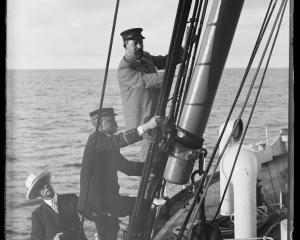
When the ground cools at night, cooling the air above it, the water vapour in the air usually forms drops of water or dew. But on especially cold nights, when temperatures drop to or below 0degC, the moisture freezes to create frost, which forms on objects such as plants or cars.
Frost is most common in low-lying areas because cool air is denser and collects in valleys, producing a marked difference in temperature between the top of a hill and a valley.
Eyewitness report: Sam Leask severe frost Ophir, July 3, 1995.
For 16 years the residents of Ophir were under the mistaken assumption the Central Otago town held the record for New Zealand’s coldest day a bone-chilling -21.6degC recorded on July 3 , 1995.
But then climate scientists who were digitising old paper records discovered that on July 17, 1903, the nearby township of Eweburn, Ranfurly, had experienced an even chillier -25.6degC temperature, eclipsing Ophir’s record.
For Ophir sheep farmers Sam and Irene Leask, who have lived all their lives in the region, and well remember the freezing week in 1995, the difference is somewhat academic.
"It’s hard to believe how cold it can actually get. Everything was frozen when you touched it. You had to have your gloves on and had to take them off to do small jobs around the farm, such as undo small bolts," says Sam.

"There was very little thaw, and then a series of frosts occurred two or three days into the cold spell. The region became fogged in and it really started to freeze up with a hoar frost.
"It hit -21.6degC between five and seven in the morning. Around sunrise is the time when you get the coldest temperatures and frost. The maximum daytime temperature I recorded that day was -17degC, although that isn’t an official figure.
"At that stage we were trying to thaw out the diesel in the tractor — you can imagine how successful that was. The big chill continued for another few days."
Sam reckons the next morning the temperature was about the same as the day before. For the next few days, a dense fog settled over the valley, keeping temperatures low.
"There was no sun, and any water on the roof would come down and form icicles right round the house. Anything steel, like a waratah, if you tried to bend it, it would just snap off, that’s how cold it was. It went on for four or five days; we were in a deep-freeze situation.
"I remember going to Omakau in the tractor for diesel and we ran into a warm wind which was actually blowing at about 2degC and we just thought it was summertime. It’s a measure of how much you get used to the cold that when you get a breeze of 2degC — which isn’t very high — it felt warm."
Sam takes pride in the fact he never lost any sheep, even though some of them were stuck frozen to the snow. At the time, the couple ran 3000 hardy Polworths, a breed composed of three-quarters merino and one-quarter Lincoln.

Ophir, named for the fabled biblical port from where King Solomon received gold, has witnessed other memorable frigid moments. Sam remembers how residents were able to enjoy curling on the frozen Manuherikia River in early June, 1992, only the second time this had happened since the mid-nineteenth century.
Newspaper accounts from the July 1903 event tell of an extended period of freezing weather lasting many weeks all over the Otago region. Four preconditions were present for the coldest day ever recorded: fresh snow cover on the ground; slow-moving high pressure; clear skies; and a drying mechanism, such as a hoar frost.
These spectacular frosts remove moisture from the atmosphere and transfer it to vegetation.
Near Middlemarch on the morning of July 17, 1903, it was reported that the frost had a peculiar and beautiful effect on the vegetation, the spikes of pine trees being converted to icicles, and horseshoes attached to fences transformed into icicles of about the thickness of a finger.
At Ranfurly, nearly all the liquids in the bottles, with the exception of spirits, froze solid. Sometimes the bottles broke, leaving the contents standing on the shelf in a solid block. The 2.10pm train from Dunedin to Ida Valley could not travel beyond Middlemarch because water needed for the engine had frozen in the large tanks.
The book
New Zealand's Wild Weather, MetService, Penguin, RRP $45












